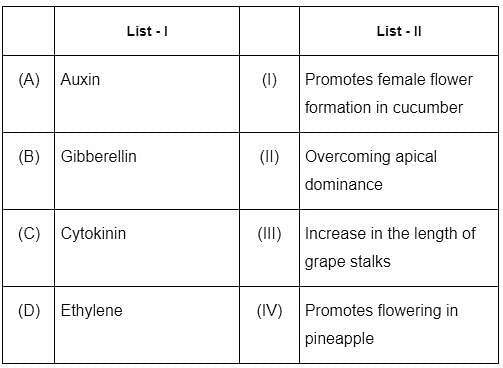Test: Plant Growth & Development - 4 - NEET MCQ
30 Questions MCQ Test Topic-wise MCQ Tests for NEET - Test: Plant Growth & Development - 4
Which of the following provides medium for enzymatic activities of the plant?
| 1 Crore+ students have signed up on EduRev. Have you? Download the App |
Which of the following is essential for the growth of the plants?
Which one of the following hormone is concerned chiefly with root initiation?
What causes a green plant to bend towards light as it grows?
Which of the following phenomena includes all the changes undergone by a living plant from seed emergence to death?
Elongation and thickening of sclerenchyma cells are an example of __________
Which of the following induces femaleness in plants ?
Which one is prevents over–ripening of banana and browning of cut fruits ?
Which of the following processes lead to the formation of secondary xylem and phloem?
Statement A: Most plants undergo indeterminate growth, growing as long as the plant lives.
Statement B: Indeterminate growth is synonymous to immortality.
Which of the following is a gaseous hormone?
The phenomenon which is influenced by auxin and also played a major role in its discovery :
Which of the following statements is not correct ?
Match List - I with List - II.

Choose the correct answer from the options given below :
The hormone responsible for enhancement of the respiration rate of fruits thereby leading to its early ripening is ________
Spraying of which of the following phytohormone on juvenile conifers helps hastening the maturity period, that leads early seed production?
Which hormone promotes internode/petiole elongation in deep water rice?
Which of the following auxins are widely used as herbicides -
Which of the following growth regulators is an adenine derivative?
Production of Cucumber has increased manifold in recent years. Application of which of the following phytohormones has resulted in this increased yield as the hormone is known to produce female flowers in the plants:
The compounds that inhibit the action of auxin are known as -
The ability of plants to follow different pathways in response to environment leading to formation of different kinds of structures is called
The site of perception of light in plants during photoperiodism is
Which one of the following plants does not show plasticity?
The plant hormone used to destroy weeds in a field
|
9 docs|1272 tests
|

















